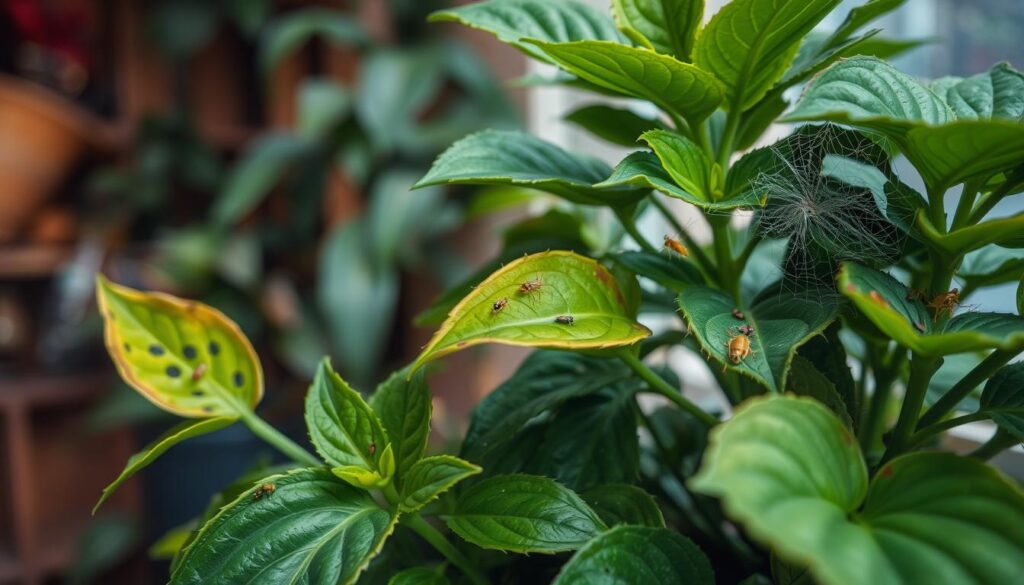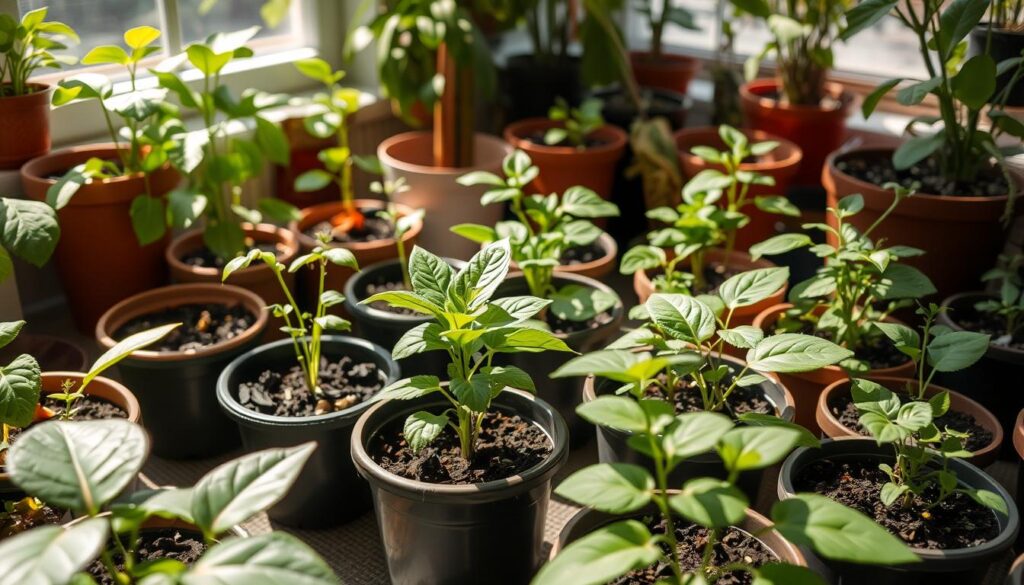Did you know that nearly 30% of indoor plants fail to thrive due to diseases? These diseases could have been prevented or treated. Spotting plant diseases early is key to keeping your indoor garden healthy.
Indoor plant diseases can sneak up on you, causing lasting damage if not caught quickly. Knowing how to identify these issues is crucial for growing healthy plants.
In this section, we’ll explore indoor plant diseases and their impact on your plants. We’ll also stress the importance of catching diseases early and acting fast. By being proactive, you can keep your plants thriving and your home full of life.
Key Takeaways
- Approximately 30% of indoor plants suffer from preventable diseases.
- Early detection is crucial for effective treatment of indoor plant diseases.
- Understanding the causes of plant diseases helps in fixing plant problems.
- Proactive care leads to healthier indoor plants.
- Identifying symptoms can save your plants from irreversible damage.
- Well-informed plant care enhances your indoor gardening experience.
Understanding Indoor Plant Diseases
Indoor plant diseases can harm your favorite plants. It’s important to know what causes them. These problems come from things like fungi, bacteria, and viruses. They can also be caused by not watering or lighting plants right.
What Are Indoor Plant Diseases?
Indoor plant diseases are problems that affect houseplants. They come from different pathogens and bad conditions. These issues can make plants look sick and hurt their growth.
Common Causes of Indoor Plant Diseases
Knowing why indoor plant diseases happen is key for plant lovers. There are a few main reasons:
- Indoor Plant Fungus: Fungi grow well in damp places, causing spots and rot.
- Improper Watering: Too much or too little water stresses plants, making them sick.
- Poor Light Conditions: Without enough light, plants get weak and can’t fight off diseases.
- Pests: Pests like insects harm plants and spread diseases fast.
| Cause | Effect on Plants | Symptoms |
|---|---|---|
| Indoor Plant Fungus | Can lead to decay and dieback | Black spots, mold growth |
| Improper Watering | Stunts growth and root development | Wilting, yellowing leaves |
| Poor Light Conditions | Reduces photosynthesis and vigor | Legginess, pale leaves |
| Pests | Compromise overall health and introduce pathogens | Visible insects, sticky residue |
Early Signs of Plant Diseases
Spotting indoor plant diseases early is key to keeping them healthy. Early signs often show up as specific symptoms. By watching for these signs, you can act fast and keep your plants happy.
Yellowing Leaves
Yellow leaves are a common early warning sign. They can mean your plant lacks nutrients, gets too much water, or has pests. Checking your plant’s leaves often helps you catch this problem early.
Wilting Leaves
Wilting leaves mean your plant is stressed. It might not have enough water, have root rot, or face other environmental challenges. Spotting this symptom early lets you fix your care routine.
Stunted Growth
Stunted growth is a clear sign something’s wrong. If your plants aren’t growing right, it could be a disease or bad care. Catching this sign early helps you treat it and get your plants growing well again.
| Symptoms | Possible Causes | Recommended Actions |
|---|---|---|
| Yellowing Leaves | Nutrient deficiencies, overwatering, pests | Check soil moisture, fertilize, inspect for pests |
| Wilting Leaves | Insufficient water, root rot, environmental stress | Water appropriately, check root health, adjust environment |
| Stunted Growth | Improper light, nutrient issues, diseases | Ensure adequate light, fertilize, examine for illnesses |
Fungal Diseases in Indoor Plants
Fungal diseases are common problems for indoor plants. It’s important to know how to spot them to keep your plants healthy. Catching fungal infections early, like root rot and powdery mildew, can help a lot. The best way to handle these issues is to recognize the signs and change how you care for your plants.
Identifying Fungal Infections
Indoor plant fungus shows clear signs. Look for yellowing leaves that might fall off. White, powdery spots on leaves mean powdery mildew. Dark, mushy roots are a sign of root rot, a serious problem that needs quick action. Checking your plants often helps catch fungal infections early.
Common Fungal Diseases to Watch For
Several fungal diseases can harm indoor plants:
- Powdery Mildew: White fungal growth on leaves, especially in humid environments.
- Root Rot: Overwatering and poor drainage lead to mushy, dark roots.
- Fusarium Wilt: Causes yellowing and wilting of leaves, affecting the entire plant.
- Botrytis Blight: Grey mold that thrives in damp conditions, presenting on flowers and leaves.
By watering right and making sure plants have enough air, you can lower the risk of these diseases. Catching problems early is key to treating them and keeping your indoor garden healthy.
Bacterial Infections in Plants
Bacterial infections can harm indoor plants, causing diseases. Knowing the symptoms and how to prevent them is key. This helps keep your plants healthy and green.
Symptoms of Bacterial Diseases
Spotting bacterial diseases in indoor plants is important. Look out for these signs:
- Leaf spots: Dark, wet spots on leaves that grow bigger.
- Soft rot: Bacteria cause mushy, discolored stems and roots.
- Wilting: Plants look droopy even with enough water because of root damage.
- Stunted growth: Plants grow slowly, with smaller leaves.
Preventing Bacterial Infections
To stop plant diseases, take good care of your plants. Here are some tips:
- Choose disease-resistant plants to lower infection risk.
- Clean pots and tools before using them.
- Water plants right, keeping moisture just right.
- Don’t water from above to avoid bacterial growth.
- Use good gardening practices like crop rotation and removing sick parts.
| Symptom | Description | Prevention Method |
|---|---|---|
| Leaf spots | Dark, water-soaked areas that expand | Use resistant varieties, sanitize tools |
| Soft rot | Mushy, discolored stems and roots | Avoid waterlogged conditions |
| Wilting | Drooping despite adequate watering | Check root health, avoid overcrowding |
| Stunted growth | Reduced leaf size and slower development | Maintain balanced nutrient levels |
Viral Diseases Affecting Indoor Plants
Viral diseases in plants are a big problem for indoor plants. Infections like mosaic virus and leaf curl virus can be very harmful. It’s important to spot these viruses early to prevent damage.
Recognizing Viral Symptoms
Identifying viral infections requires careful observation. Look out for:
- Mosaic patterns on leaves, which may appear as yellow or light green patches.
- Leaf curling> or distortion that affects the overall shape of foliage.
- Stunted growth where plants do not reach their expected size or vigor.
- Chlorosis, characterized by yellowing between the veins of leaves.
Spotting these signs early is key to treating viral infections and keeping plants healthy.
Treatments for Viral Infections
Managing viral diseases in plants is tough, but there are steps you can take:
- Remove infected plants to prevent the virus from spreading.
- Disinfect tools before using them to avoid spreading the virus.
- Maintain plant hygiene by cleaning leaves and ensuring good air flow.
- Use resistant varieties when possible, as some plants are more resistant to viruses.
Prevention is key. Early detection and treatment can help keep your indoor plants healthy.
| Viral Disease | Recognizing Symptoms | Treatment Options |
|---|---|---|
| Mosaic Virus | Yellow and green mottled leaves | Remove infected plants, clean tools |
| Leaf Curl Virus | Leaves curling and distorting | Remove infected plants, improve air circulation |
| Tomato Spotted Wilt Virus | Wilting and discoloration of leaves | Control pests, isolate infected plants |
Pest-Induced Plant Diseases
Indoor plant pests can harm your plants, causing diseases. It’s important to spot these problems early. This helps keep your plants healthy.
Common Pests That Cause Diseases
Some pests are known for causing diseases in indoor plants. Knowing about these pests helps you act fast:
- Spider Mites: These tiny bugs suck sap, causing leaves to turn yellow and wilt.
- Aphids: Aphids breed quickly and can spread viruses, harming plants.
- Mealybugs: These pests look like cotton and can weaken plants, making them more prone to fungal infections.
Signs of Pest Damage
Spotting pest damage early is key. Here are some signs to watch for:
- Discolored Leaves: Yellow or brown leaves often mean pests are present.
- Sticky Residue: A sweet substance on leaves could mean aphids.
- Webbing: Fine webs on plants are a clear sign of spider mites.

By staying alert and knowing about these pests, you can stop diseases. Quick action keeps your plants healthy and thriving.
Diagnosing Plant Problems
It’s key to spot problems early to keep indoor plants healthy. Start by looking closely at your plants for signs like color changes, growth issues, or pests. Catching these issues early can help fix them. Using special tools can give you more insight into what’s wrong.
Visual Inspection Techniques
When checking your plants, look for signs of trouble. Focus on:
- Leaves: Watch for yellowing, spots, or wilting.
- Stems: Check for color changes or damage.
- Roots: Look for rot or odd growth.
Regular checks help catch diseases early. This way, you can act fast to prevent bigger problems.
Utilizing Plant Diagnostic Tools
Using tools can help you find and fix plant problems better. Some useful tools are:
- Moisture Meters: Check soil moisture to avoid watering mistakes.
- Magnifying Lenses: Find pests or fungi you can’t see with your eyes.
- pH Test Kits: See if your soil’s too acidic or alkaline.
By using these tools and your eyes, you can really understand your plants. This leads to better care and fixing problems.
Fixing Indoor Plant Diseases
Fixing indoor plant diseases needs a mix of strategies. Using preventive practices helps a lot. Sometimes, you might need to use chemicals too. Knowing how to do both can make your plants healthier.
Cultural Practices for Prevention
Preventive cultural practices are key to keeping plants healthy. These include:
- Crop Rotation: Switching plants can break disease cycles.
- Proper Lighting: Make sure plants get enough light to grow strong.
- Humidity Control: Keep humidity right to stop fungi.
- Sanitation: Clean pots and tools often to kill germs.
By using these practices, you can stop diseases before they start. This helps fix plant problems effectively.
Chemical Treatments and Fungicides
When prevention isn’t enough, chemicals are needed. It’s crucial to use fungicides and treatments wisely.
Here are some tips for using chemicals well:
- Follow Labels: Always follow the dosage and frequency instructions.
- Targeted Application: Spray or apply treatments directly to sick spots for best results.
- Time it Right: Treat plants when it’s cooler to avoid stress.
Using chemicals carefully helps solve problems without harming your plants or indoor space.
Importance of Proper Care
Proper care is key to keeping indoor plants healthy. Good watering and nutrient management boost your garden’s health and beauty.
Watering Practices to Avoid Disease
Right watering is crucial to stop plant diseases. Too much water causes root rot, while too little stresses plants. Find a consistent watering schedule for each plant.
- Check soil moisture before watering.
- Avoid letting plants sit in standing water.
- Adjust watering frequency during seasonal changes.
Nutrient Management for Healthy Plants
Plant care goes beyond watering. It also means giving the right nutrients. The right nutrients help plants grow strong and fight off diseases.
| Nutrient | Function | Plant Sources |
|---|---|---|
| Nitrogen | Promotes leaf growth | Compost, fish emulsion |
| Phosphorus | Enhances root development | Bone meal, rock phosphate |
| Potassium | Increases disease resistance | Kelp, greensand |

Maintaining Plant Hygiene
Keeping your indoor plants healthy is key. Cleaning and disinfecting pots regularly helps prevent diseases from spreading. It’s also important to choose the right soil for your plants to thrive.
Cleaning and Disinfecting Pots
Cleaning and disinfecting pots is crucial. It gets rid of harmful pathogens and pests. Here’s how to do it right:
- Remove any old soil and plant debris from the pot.
- Wash the pot with warm, soapy water to remove residues.
- Rinse thoroughly to ensure no soap remains.
- Apply a bleach solution (1 part bleach to 9 parts water) to disinfect the pot.
- Allow the pot to air dry completely before reusing it.
Choosing the Right Soil
The right soil is vital for your plants’ health. A good soil mix gives them the nutrients they need. It also ensures good drainage and aeration. Here’s what to look for:
- Type of Plant: Different plants need different soils. Find out what your plants prefer.
- Soil Composition: Choose a mix with organic matter, perlite, or vermiculite for better drainage.
- Pre-packaged Mixes: Many brands offer mixes for specific plants. This can make your choice easier.
When to Seek Professional Help
It can be tough to figure out plant problems on your own. Sometimes, you need to know when to ask for help. If your plants keep getting sick, grow poorly, or die off, it’s time to get expert advice. A plant specialist can help find and fix the issues.
Signs You Need an Expert
- Persistent yellowing or wilting leaves despite ideal conditions.
- Visible pests or strange growth patterns on multiple plants.
- Unexpected plant deaths that seem unrelated to care practices.
- Inability to identify diseases despite extensive research.
- Frequent reoccurrence of the same issues in different plants.
Finding a Plant Specialist
Looking for a plant specialist can really help. Start by visiting local nurseries or garden centers. They often have experts in indoor plant care. You can also find recommendations online or in community forums.
Here are some things to think about when searching:
| Criteria | What to Look For |
|---|---|
| Experience | Look for specialists with several years in plant care and disease management. |
| Certifications | Check for professional certifications from recognized agricultural organizations. |
| Reviews | Read customer reviews and testimonials to gauge satisfaction rates. |
| Services Offered | Inquire if they provide a range of services including diagnostics, treatments, and general care advice. |
Preventing Future Diseases
Keeping your indoor plants healthy is key to avoiding diseases. Regular checks and care can catch problems early. This means looking at leaves and soil for signs of trouble or pests.
By watching your plants closely, you can fix issues fast. This keeps them looking good and feeling strong.
Routine Checks and Maintenance
Having a regular maintenance plan is crucial. Set aside time each week to check on your plants. This includes checking the water and light they get.
Optimizing your plant’s environment helps prevent diseases. It also keeps them healthy and thriving.
Educating Yourself About Plant Care
Learning about plant care is very important. Knowing what your plants need, like seasonal changes, helps them stay healthy. You can find lots of information in books, workshops, and online.
Being well-informed lets you create the best indoor space for your plants. It also helps you prevent diseases from happening in the first place.
FAQ
What are the common indoor plant diseases I should look out for?
Indoor plant diseases include fungal infections like powdery mildew and bacterial leaf spots. Viral diseases, such as mosaic virus, are also common. Each disease has its own symptoms that can harm your plants.
How can I recognize the signs of indoor plant diseases early?
Look out for yellowing leaves, wilting, and stunted growth. Catching these signs early can help prevent bigger problems.
What treatments are available for indoor plant fungus?
Treat fungal infections with fungicides and improve air circulation. Adjust your watering to prevent fungal growth. Make sure plants dry out between waterings.
How can I prevent indoor plant diseases from occurring?
Prevent diseases by watering right, using quality soil, and cleaning pots. Good care and pest control are key. Keep an eye out for pests too.
What are some common pests that lead to indoor plant diseases?
Spider mites, aphids, and mealybugs are common pests. They can damage plants and spread diseases.
How can I diagnose what is wrong with my indoor plants?
Check for signs like discoloration or wilting. Use tools like moisture meters to check soil health. Regular observation is best.
What should I do if my indoor plant has a bacterial infection?
Remove infected leaves and avoid overhead watering. Improve air circulation. Consider using bactericides as treatment.
When should I consider seeking professional help for my plants?
Seek help for severe symptoms or if many plants are sick. A plant specialist can offer expert advice and care.
How can I maintain plant hygiene to prevent diseases?
Clean and disinfect pots and tools regularly. Choose the right soil mix for your plants. This can help prevent diseases.
What are some cultural practices to fix indoor plant diseases?
Practices include crop rotation and maintaining optimal lighting and humidity. Proper drainage in pots is also important. These steps can help prevent and treat diseases.


